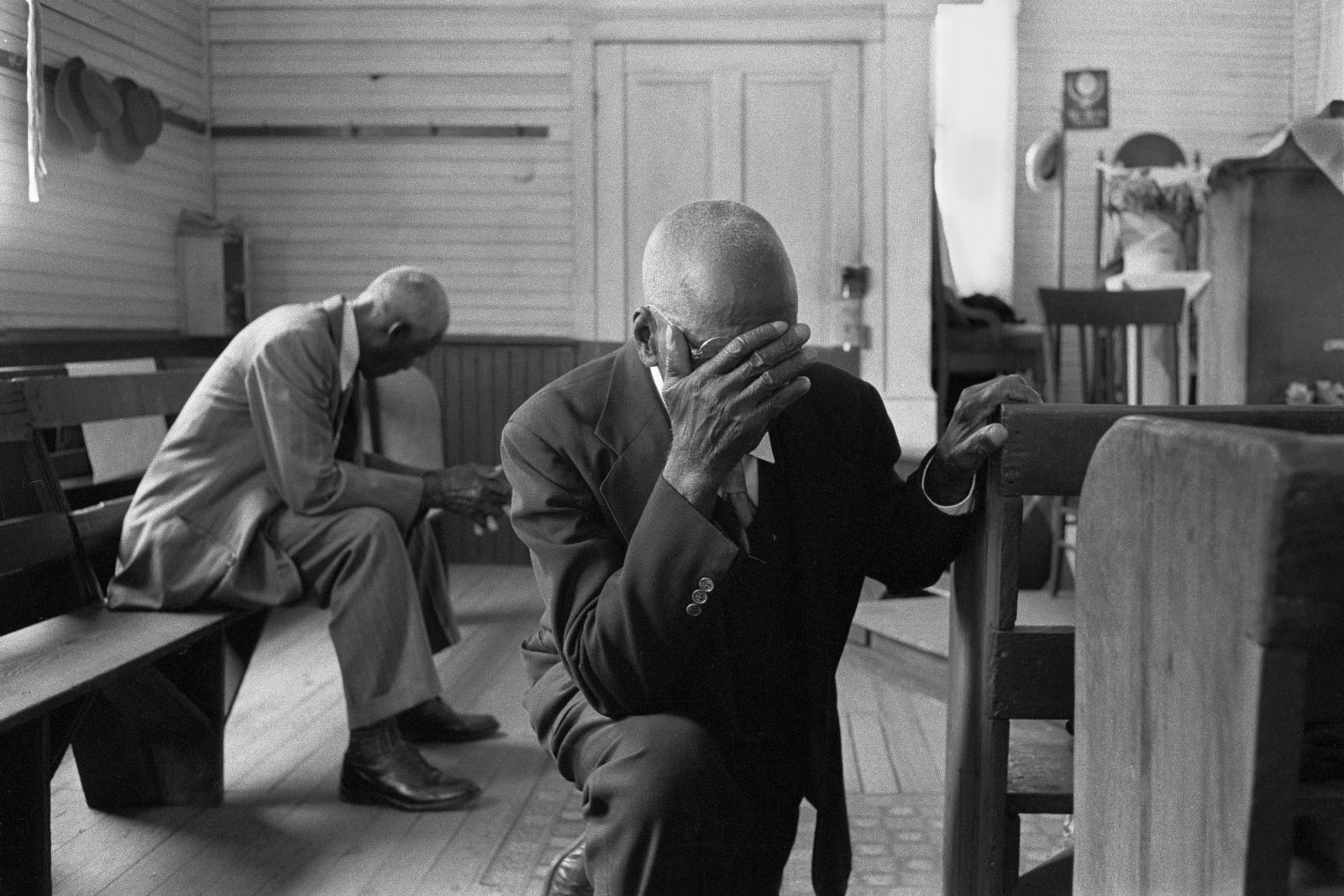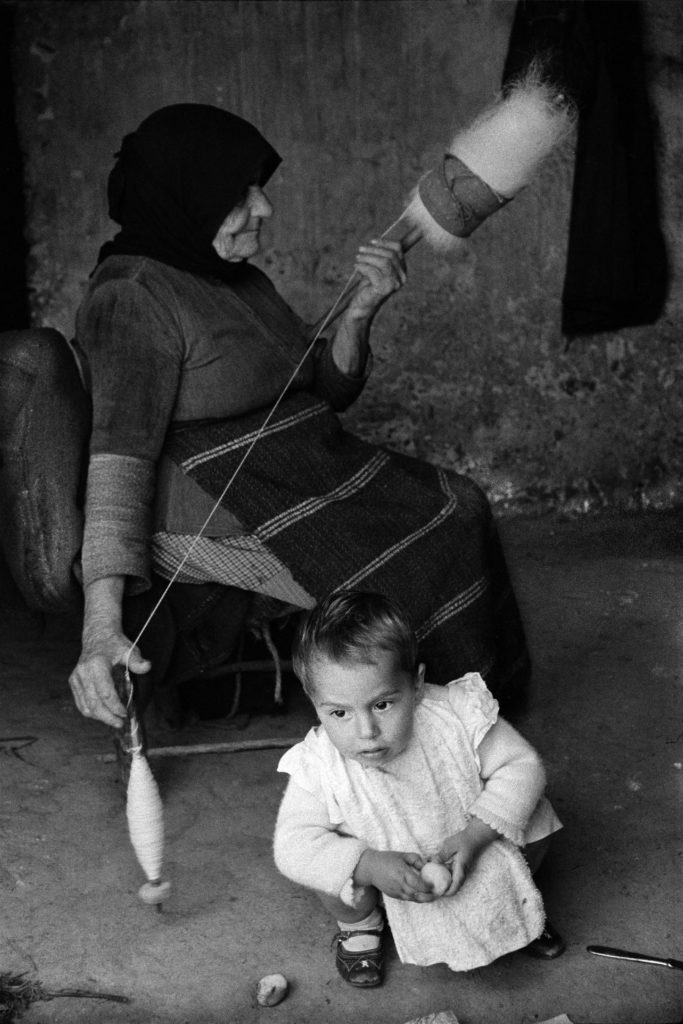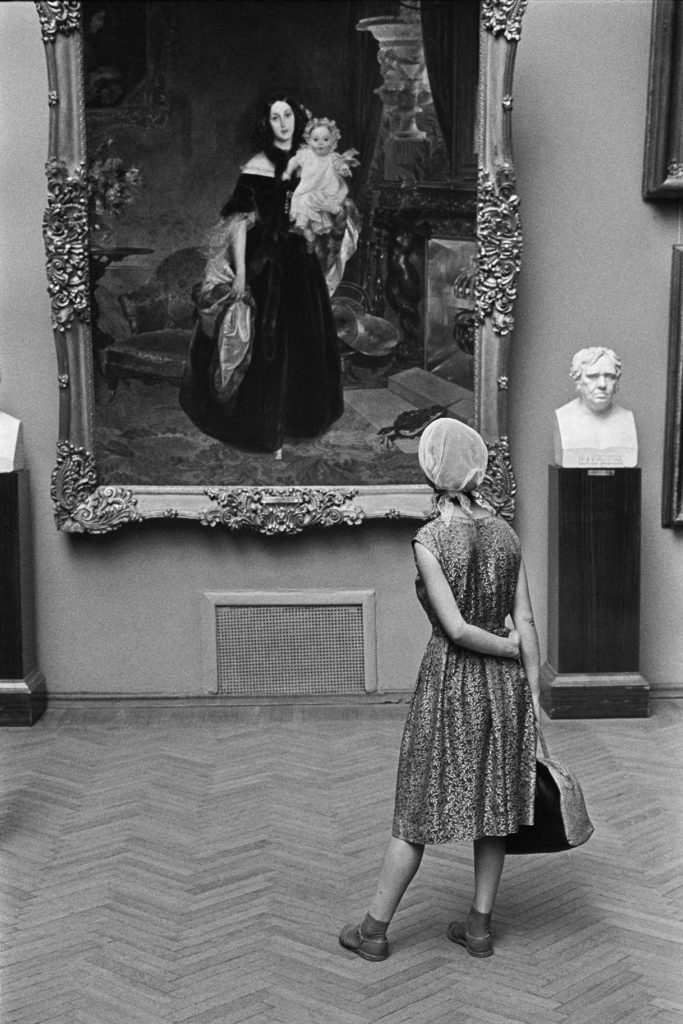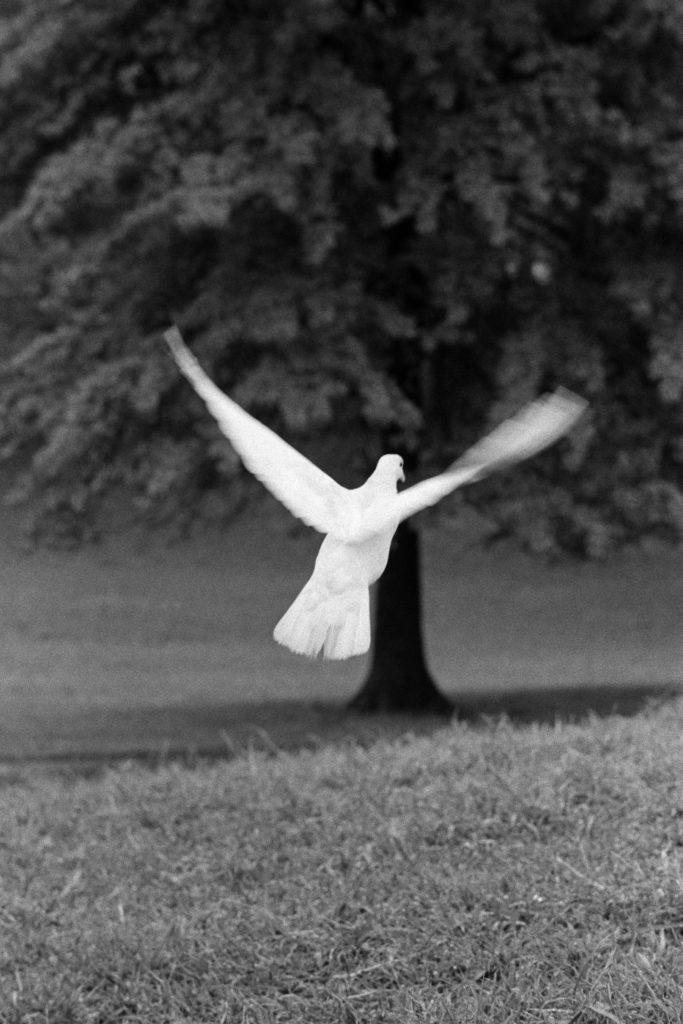
In 1952, Costa traveled to Daufuskie Island in hopes of amassing his first collection of photographs. These men, most likely elders of the church, were praying during the Sunday morning service while Costa walked among them, quietly taking pictures. He found the experience both emotionally moving and serenely beautiful.
Split-second snapshots of life flit into view and then, just as quickly, disappear: a woman sitting in a lounge chair, beer in hand, next to piles of neatly folded clothes; a tuxedo-clad musician drawing a bow across the strings of his violin; a child falling. Each is an example of a specific image that generally goes unnoticed and is usually lost forever.
Unless Constantine “Costa” Manos is there to save it.
A Columbia native and celebrated photographer, Costa has spent his life not only being aware of these fleeting images, but he has also mastered the art of capturing on film what he calls “magic moments.”
“It’s very difficult,” says Costa. “It takes a lot of hard work and patience. I don’t want to take pictures of just what things look like. When I push the button, it is very important to me to have a moment in the picture — something that has never happened before and will never happen again — that’s the kind of moment that I love.”
Now living in Cape Cod, Massachusetts, Costa is unabashedly enthusiastic about every subject, but he is particularly passionate about his photography.
“I like to take pictures that ask questions but don’t give answers,” he says. “I want the pictures to engage the viewer — make him wonder, make him sad, make him happy — to evoke an emotional response. I think a really successful picture is one that people will remember.”
It is unlikely that Costa or his pictures will ever be forgotten. His career spans decades and has earned him membership in the prestigious photography cooperative, Magnum Photos. He has worked for Esquire, LIFE, Look and Time Life books, covering events such as Martin Luther King’s funeral, the Montgomery Bus Boycott, and President Richard Nixon’s inauguration. Costa has also published six books, including Portrait of A Symphony, 1960, which documents the Boston Symphony Orchestra; A Greek Portfolio, 1972, an Arles and Leipzig Book Fair award winner; Bostonians, 1975, a collection of photographs from the Where’s Boston exhibition, for which he was the chief photographer; and A Greek Portfolio, Unknown Pictures, which was published in 2013.
Costa’s photographs are included in the permanent collections of the Museum of Modern Art, New York; the Museum of Fine Arts, Boston; the Art Institute of Chicago; the Bibliothéque Nationale, Paris; George Eastman House, Rochester; The Museum of Fine Arts, Houston; and the Benaki Museum, Athens. In 2003, his books American Color, 1995, and American Color 2, 2009, earned him the highly coveted Leica Medal of Excellence.
The origin of these achievements happened at a time in life when most young people can barely navigate a lunchroom, much less settle on a career. “I joined the camera club in junior high school,” he says.

Costa, then called Gus by his teachers and schoolmates, first attended Columbia’s Wardlaw Junior High in 1947. It is now an assisted living facility on Elmwood Avenue. There he discovered a natural affinity for photography and began to cultivate the discipline and skill it would take to turn a teenage hobby into an illustrious career.
“They had a very nice darkroom, and the photography teacher, Sadie Cox, taught me my craft,” he says. “That is where I got my basic training. Developing film and making prints was all very different back then. Nobody develops film anymore, but for me, it was really a terrific thing, and I was passionate about it.”
Costa also credits his Greek immigrant parents, Aphrodite and Dimitri Manos, for his success. Dimitri fled his village in Turkey when the Turks began drafting Greek boys into the army, making his way to America when he was just 17. Aphrodite was a refugee from Greece, and eventually the pair met, married, and immersed themselves in South Carolina’s Greek community. Dimitri opened a restaurant in Columbia called the Washington Street Cafe. Even though money was tight, Costa remembers both parents being extremely supportive and encouraging to him as well as to his sister, Irene, and brother, Theo.
“We all had musical instruments,” says Costa. “We had no connection to music, but my sister was walking with my father down to the restaurant, and there was a pawn shop with a violin in the window, and she started crying. She wanted that violin.”
Irene got her violin; Theo, a piano; and Costa, a flute.
“Our parents were just wonderful, good, simple people,” he says. “They knew nothing about classical music, but they supported us in whatever we wanted to do.”
That included allowing Costa to set up a darkroom in the basement of their house, originally using an orange crate and a box camera for an enlarger. He also began subscribing to Popular Photography, which led to the discovery of the man who had the greatest influence on Costa’s style and approach, Henri Cartier-Bresson, whom Costa describes as his “mentor from afar.”
Cartier-Bresson, the great French photographer who was considered a trailblazer in the art of street photography, was a founding member of Magnum Photos, named for the four founders who were said to open a magnum of Champagne before each meeting. Young Costa was so inspired by this maven of the candid photograph that he bought the same camera favored by Cartier-Bresson. “I’ve used a Leica all my life,” says Costa.
While he very successfully honed his craft through his high school years at Columbia High, it was Irene’s talents on the violin that landed Costa the job of photographer at the Brevard Music Festival in North Carolina.
“My sister got a scholarship,” he explains. “I played the flute, but I didn’t get a scholarship. I really wanted to go, so I asked if they needed a photographer.”
After spending several summers as the Brevard photographer, Costa thought he might try for a bigger posting. At 19 years of age, he wrote a letter addressed to the Boston Symphony asking that he be considered as an assistant photographer for their annual summer festival in Tanglewood. He was hired, but not for the position he originally requested.
“I thought they were hiring me to be an assistant,” he says. “But they were hiring me to be the chief photographer for the Boston Symphony Orchestra! So I loaded up my old Ford with darkroom equipment in the trunk and drove all the way from South Carolina to Massachusetts. I spent two wonderful summers photographing the symphony.”
While Aphrodite and Dimitri had very little formal education themselves, they were determined that all three children attend college. Costa was awarded a scholarship in photojournalism from the University of South Carolina, but it was clear after the first year that he had already mastered photography. He switched his major to English.
“It was the best thing that could have happened to me because instead of learning how to develop film again, I was free,” he says. “I could pick any course I wanted, and I got a much better education because of it.”
Costa decided to amass his first serious collection of photographs while still a student at USC. Armed with his Leica and lenses, he hitched a ride on a crab boat and rode out to Daufuskie Island, a small land mass located between Hilton Head Island and Savannah. Daufuskie, a Creek Indian name meaning “Sharp Feather,” had 11 plantation homes before the Civil War.

During the war, the plantation owners fled, but the former slaves remained and flourished, making their livelihood from the crab and oyster industries.
Spending nights on a cot in the back of an old general store, Costa used his days applying the techniques and philosophies he had learned from Cartier-Bresson concerning street photography, composition, and cropping.
“I never crop a picture,” says Costa, “so I try to take a picture that is perfect when I shoot it. My photos are exactly the way they were made — I don’t chop around the edges to make them better.”
His time on Daufuskie not only solidified his determination to make photography his life’s work, but it also influenced his view of what was then a highly controversial and hotly debated topic: state-sanctioned segregation of public schools. Months before the 1954 landmark Brown vs. Board of Education of Topeka decision, in which the Supreme Court ruled this practice unconstitutional, Costa took the initiative to write three editorials in the USC Gamecock newspaper in favor of desegregation.
“I think being with the people on Daufuskie Island definitely had an influence on me,” he explains. “They were such good, decent people. They had a church and a school and an orderly life — it was a good community.”

Still enrolled at USC, but emboldened from the success of his Daufuskie shoot, Costa drove to New York to pursue what had been his dream since he was first introduced to photography and the world of Cartier-Bresson: membership into that elusive cooperative, Magnum Photos.
One of the first people he met at the Magnum office was eminent photographer Cornell Capa, who was kind, supportive, and adamant that Costa go back to school and return when he was older. The trip, however, was not a complete loss.
“Capa invited me to go down to a bar and have a drink with him,” says Costa. “I’d never been to a bar before, so when he said, ‘Well, what will you have?’ I said, ‘I’ll have what you’re having.’ And I’ve been drinking Scotch ever since.”
Heeding Capa’s advice, Costa completed his degree and then served two years in the U.S. Army. Stationed in Germany, he first developed aerial reconnaissance film and was later transferred to the Stars and Stripes newspaper, which served the American military. During furlough time from the Army, he made a series of photos in Europe, later to be entitled A Soldier’s Pictures. As soon as he was discharged, he went to New York to pursue his calling, make his mark on the field of photography, and take back his name.
“I never liked the name Gus,” he says. “My name is Constantine — a proper Greek name — and then you can make it Costa, that’s a short version. Gus is a name they stick on Greek boys. It comes from ‘Cos’ to ‘Gus’ I think, and I got stuck with that. I really hated it, so when I went to New York, I took back my own name.”
One of Costa’s earliest endeavors was a project he did for himself in Central Park. When viewed individually, the images from this collection are intriguing, leaving one to wonder about the people in the photos: the old couple sitting on a bench; a woman whispering to her poodle; a young boy preparing to hit a baseball, the ball suspended in air, a moment caught forever. But viewed together, it becomes clear that what ties all of these photographs together is the little oak tree standing by itself — the tree is in every picture.
“I had this idea of what a tree sees around it every day,” explains Costa. “Sometimes you can have an idea that you make into a whole body of work. I wanted to see what a tree sees, so it was an idea, that’s all.”
Costa traveled all over the world, chasing light, pursuing ideas, looking for moments. He lived in Greece for two years, putting together the anthology that would later lead to several awards. While there, he took a trip to Paris, dropped off a box of his Greek portfolio prints to the French Magnum Photos office, and then returned to Athens to continue work on his collection. Deciding that the best pictures would be in the most isolated villages, Costa traveled to remote areas in Greece.
The photographs came easily; the mail did not.
“About a year later, I was still in Greece,” he says, “and a friend of mine sent me my mail in this big package. I opened it, and there it was. A letter that read, ‘Dear Constantine, you’ve been invited to become a member of Magnum Photos.’”
The moment was both electrifying and bittersweet. Being so far from family and friends, he had no one with whom he could share his joy, but the dream that had started in a Columbia junior high school darkroom had finally come to fruition.

Costa still works in his studio every day and can frequently be seen taking pictures around his Cape Cod community. He also mentors young photographers and leads workshops where, inevitably, the topic of cell phone cameras will arise.
“Now everybody is taking pictures with their telephones,” he says. “All these pictures are just floating around in the air. But I believe a photograph doesn’t really exist until it is a real object … something you can hold in your hand and put in a frame and save as a treasure in a box.”
For Costa, the print is a reflection of the art of photography that illustrates the craftsmanship of its creator. It is part of a process in which one does not just take a picture but makes a picture. Costa stresses the importance of creating prints that will endure past a perfunctory glance, ones that will live a long life and give the viewer comfort for many years to come.
“A successful picture is a surprise,” he says. “It is all about the subject matter, the composition, the unexpected — that moment you have never seen before and will never see again.”
Costa has accumulated a lifetime of these surprises, creating collections that allow his fans to appreciate every moment.

Sitting down with Costa
Q: What is your favorite part of Columbia?
A: When I was little, we lived in an apartment close to the USC campus, and my sister and I used to walk around the campus. Also, we lived in an apartment next to the Town Theater on Sumter Street. We would go backstage and watch rehearsals, and that was my first taste of culture. And, we were just a block away from the State Capitol, so we used to walk around and look at the statues. I loved that area.
Q: When was the last time you were back?
A: About five years ago, I visited the new Greek Orthodox Church where I was an altar boy. All my clothes smelled of incense when I was a kid. I love that smell.
Q: What is one thing people would never guess about you?
A: I’m actually a very shy person. Sometimes it is painful for me to get in close and do these candid pictures. But over the years I have conquered it.
Q: What is one thing that really makes your day?
A: I’m very happy when I’ve had a good day at the studio, and I’ve made some new prints. And when all my temperamental machines are working properly. When they are all working, and I get some new prints, that’s a happy day.













